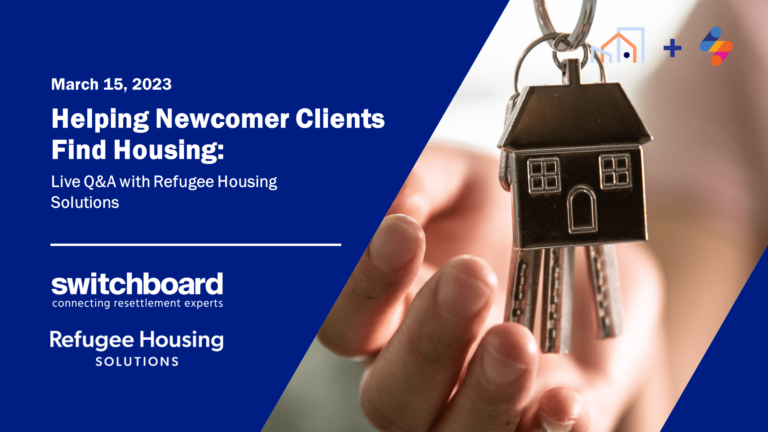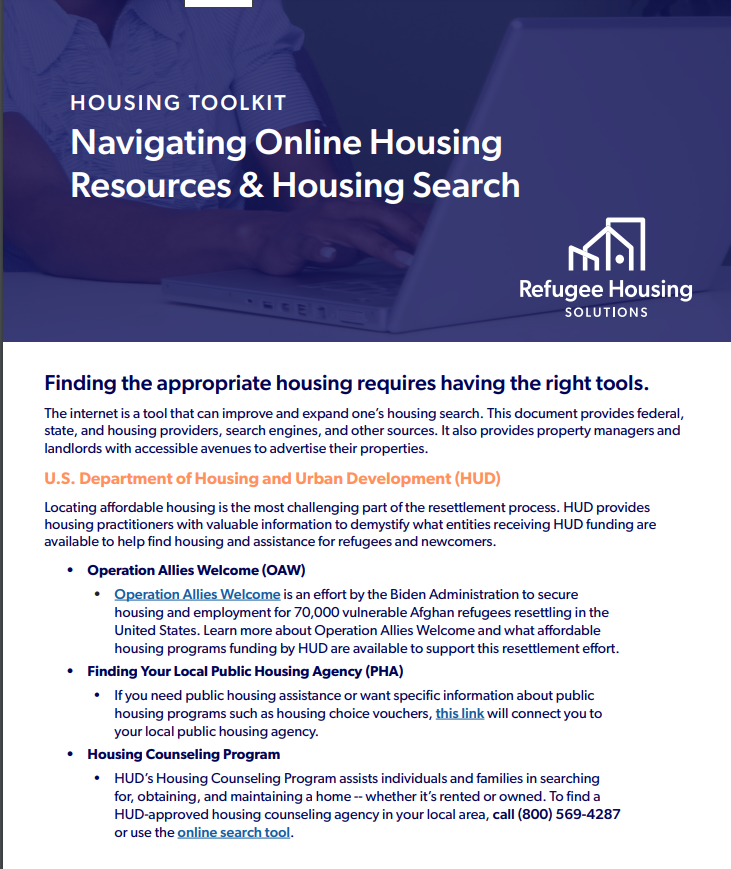Supporting Newcomers with Rental Housing: Key Information to Share with Clients
Do you get questions from clients about finding safe, affordable housing in the U.S.? This comprehensive overview provides information you can share with your clients about the rental process, from understanding leases and managing expectations to budgeting and conducting pre-move-in inspections. Switchboard has partnered with Settle In to share client-facing information on this topic in Ukrainian, Dari, Spanish, and English. Click here to access.
Understanding How Renting Works in the U.S.
When working with newcomers, it’s important to help them understand that finding housing in the U.S. can be challenging due to limited affordable options, especially for people with lower incomes. Despite the housing shortage, many people in the U.S. rent their homes rather than own them. You can explain to your clients that rent prices vary significantly based on location, with some cities being much more expensive than others.
Help your clients understand the different types of rental housing they may encounter:
- Room rental: Sharing a house with others, including common areas like kitchens and bathrooms
- Apartment: Living in a unit within a small or large building
- Single-family home: Renting an entire house exclusively for their family
When discussing rental agreements with clients, emphasize that they will typically sign an important legal document called a lease with the property owner or management company. Explain that a lease is a rental agreement where they commit to paying a specific monthly amount in exchange for the right to live in the home for a set period (usually one year). Help them understand that the lease serves as a written set of rules governing their rental arrangement.
Helping Clients Plan Their Housing Search
Before clients begin looking for available homes, guide them through careful planning:
Budgeting Guidance: Help your clients calculate how much their household can realistically afford for rent each month. Share the general guideline that rent should be approximately 30-35% of their household income after taxes. Work with them to create a realistic budget that accounts for their specific financial situation.
Identifying Essential Needs: Assist clients in creating a priority list of their family’s absolute housing requirements:
- Number of bedrooms needed
- Location considerations (proximity to work, schools, public transportation)
- Accessibility requirements (no stairs, wheelchair-accessible bathrooms, etc.)
- Other family-specific needs
Explaining the Financial Realities of U.S. Rental Housing
It’s crucial to help newcomers understand that renting involves costs beyond the monthly rent payment. Preparing clients for these expenses helps them budget effectively and avoid surprises.
Security Deposits: Explain that most rentals require a security deposit, typically equal to one month’s rent, though amounts can vary. Help clients understand that landlords use this money to cover property damage beyond normal wear or unpaid rent. Emphasize that if they maintain the unit properly, they should receive their deposit back when they move out. Prepare them for the upfront cost of both the security deposit and first month’s rent (for example, $1,500 rent + $1,500 deposit = $3,000 due before moving in).
Utilities: Advise clients to ask landlords which utilities are included in rent versus those they’ll pay separately. While water, trash removal, or heat are sometimes included, electricity, gas, and internet often are not. Help them understand they’ll need to set up utility accounts and may need to pay deposits to utility companies.
Additional Costs to Discuss:
- Application fees: Non-refundable fees ($30-$70 per adult) for background and credit checks
- Pet-related costs: Pet fees, deposits, and monthly “pet rent” if applicable
- Parking fees: In some buildings or urban areas
- Renter’s insurance: To protect personal belongings
Tenant Responsibilities: Prepare clients for their responsibilities, which affect overall costs:
- Minor maintenance (changing light bulbs, keeping the unit clean)
- Possible yard work or snow removal for single-family homes
- Following all lease terms to avoid fees or eviction
Supporting Clients in Competitive Housing Markets
Help your clients understand that finding affordable rental housing is challenging because many people compete for limited options. Prepare them for a process that requires patience and persistence. Emphasize your role and that of other community organizations in providing guidance and connecting them to local housing resources.
Housing Types and Programs to Explain:
- Rent Control/Rent Stabilization: Local laws in some cities that limit annual rent increases
- Market rate rentals: Properties where owners set any price they choose
- Mixed-income housing: Buildings with both market-rate and reduced-rent units
- Public housing: Government-subsidized housing with income-based rent
- Section 8/Housing Choice Vouchers: Government programs that help pay rent directly to landlords
When discussing subsidized housing options like public housing or Section 8, explain that while these programs can significantly reduce rent costs, they typically involve application processes and long waiting lists. Help clients understand which options might be realistic for their situation and assist them with applications when appropriate.
Guiding Pre-Move-In Inspections
Emphasize to clients the importance of inspecting their unit before signing a lease and moving in.
Explain that this inspection serves two critical purposes:
- Identifying problems they can ask the landlord to fix before move-in
- Creating documentation (photos) of existing issues to protect them from being held responsible later
Inspection Considerations to Share with Clients:
Many newcomers may not be familiar with what constitutes standard housing conditions in the U.S. or may come from places with different housing infrastructure and safety requirements. These considerations can help guide your clients through their property inspections:
General Condition:
- Overall cleanliness and maintenance
- Signs of pests (mice, insects)
- Paint condition (peeling or in good repair)
Safety Checks:
- Working smoke and carbon monoxide alarms
- Proper electrical wiring (no exposed wires near water sources)
- Windows and doors that open, close, and lock securely
Water and Plumbing:
- Water flow and temperature in all sinks and showers
- Proper toilet function
- Signs of leaks or water damage under sinks
Heating, Cooling, and Appliances:
- Functioning heater and air conditioning
- Working kitchen appliances (oven, stove, refrigerator)
Electrical Systems:
- All light switches operational
- Power to all electrical outlets (test with phone charger)
For a comprehensive inspection tool, refer clients to the Switchboard Sample Housing Walk-Through Checklist.
Where to Find Additional Resources
For additional housing support resources, connect with:
- Local housing authorities and public housing agencies
- Community organizations specializing in newcomer services
- Refugee Housing Solutions for state-specific housing rights information
- Local tenant rights organizations
If you have questions about housing assistance strategies or need additional resources for your clients, consider reaching out to housing specialists in your community or connecting with other resettlement providers through professional networks.
Sources
Settle In: A Basic Guide to Rental Housing in the U.S.
Settle In: Understanding a Lease When Renting an Apartment or a House
Refugee Housing Solutions: Know Your Rights: State-by-State Housing Guide
Switchboard: Helping Newcomers with the Housing Search
Switchboard: Sample Housing Walk-Through Checklist
U.S. Department of Housing and Urban Development (HUD): HCV Applicant and Tenant Resources
The IRC received competitive funding through the U.S. Department of Health and Human Services, Administration for Children and Families, Grant #90RB0053. The project is 100% financed by federal funds. The contents of this document are solely the responsibility of the authors and do not necessarily represent the official views of the U.S. Department of Health and Human Services, Administration for Children and Families.










